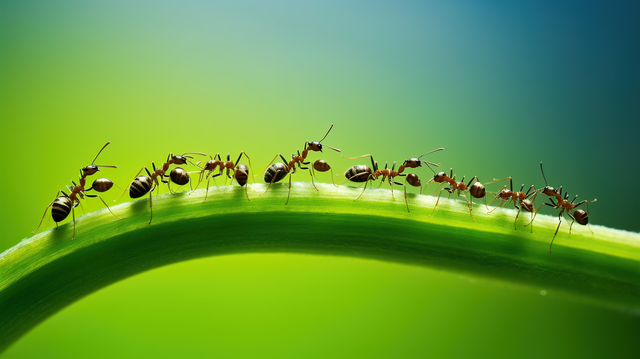If you’re dealing with an ant invasion in your home, don’t worry. There are several practical steps you can take immediately to address the issue. Like other pests, ants enter homes in search of food, water, or shelter. To get rid of ants, make food and water inaccessible. Ants are diligent foragers and will look elsewhere if they can’t find what they need in your house. Sometimes, simply sealing up food and water sources might not be enough, especially if the ants in your home eat wood and live inside the walls. If these steps don’t resolve the problem, a professional pest control service is your next best option. In nature, ants find food, water, and shelter in various ways. However, it’s often easier for them to access these resources inside a structure like your home. Moving indoors also helps ants escape natural threats like weather and predators. Food Sources Food is the primary attractant for ants. If you leave dirty dishes in the sink, crumbs on the floor, or accessible food containers, ants may come to investigate and carry the crumbs away. Ants have a strong sense of smell and enjoy a variety of foods, including: • Sugar • Carbs • Grease • Salt • Protein Because they are drawn to sweet smells, ants may also enter your house in search of laundry detergent, candles, and other scented products. While they can’t eat these items, they might find another food source while inside. Water Sources Ants need water to survive. If your home has leaky pipes, dripping faucets, or other accessible water sources, it becomes easier for ants to settle in. This need for water is one reason why ants often invade kitchens and bathrooms. To keep ants out, assess the water accessibility in your home. Monitor pet water bowls, use a dehumidifier in areas like the bathroom, and fix any leaky pipes. If ants can’t find water in your home, they won’t stay. Shelter Ants prefer dark, warm environments. Depending on the type of ant, they may build a nest inside your home, underneath it, or nearby for easy access to food and water. Knowing the type of ants you have can help you determine where they might be nesting. When ants find food, they leave a pheromone trail that guides other ants to the food source. This is why you often see ants marching in a straight line. By tracing this line, you may find where ants are entering your home and block it off. How Do Ants Get Into Your Home? Ants can enter your home through small cracks and crevices along windows, doors, and walls. They may also come inside through your basement via cracks in the foundation. Fortunately, there are practical steps you can take to prevent ants from gaining access. Cracks and Crevices Seal any cracks and crevices that could allow ants to enter. This can also improve your energy bill by preventing your air conditioning and heating system from leaking into your home’s surrounding environment. Check windows, doors, and other exterior openings. It’s also a good idea to inspect your foundation and the exterior walls of your home for any cracks or damage. Repair anything that looks suspicious, and remember that ants can enter through very small openings. Outdoor Attractants Ants are often drawn to flowering bushes in your landscaping. You might have noticed ants swarming over sweet flowers like peonies and roses. If these plants are near your house, ants may explore the exterior and find a way inside. Overgrown vegetation can also attract ants. Vines or plants growing up the side of your house or around your doors can provide a pathway into your home. By clearing these areas, you can make it harder for ants to get close enough to venture inside. Outdoor Food Sources Ants are a common nuisance at picnics due to their excellent sense of smell. If you enjoy eating outdoors or regularly leave pet food outside, ants may be attracted to your house as they search for the source of the smell. To keep ants away, clean up food, sweep away crumbs, and only put out pet food when your dog or cat is hungry. Some people surround their pet food with water, but this won’t stop ants from smelling it and coming to investigate. Preventing Ants from Entering Your Home Whether you have a few ants or a full-blown infestation, it’s important to make some changes to your housekeeping habits. Even a small number of ants can multiply quickly if they find food readily available. Here are some effective ways to make your home less inviting to ants: Regular Cleaning and Maintenance Take a close look at the inside of your house. How often do you sweep the kitchen floor? Does dirty laundry sit out in a hamper for a while before it gets washed? Ants can be attracted to the salt on worn clothes, crumbs in your kitchen, or standing water in your bathroom. To limit the ants’ food supply, try these steps: • Wipe down your table and kitchen counters after every meal. • Sweep or vacuum the floor after every meal. • Store your food in airtight, sealed containers. • Put pet food away except during meal times. • Fix any leaking or dripping pipes. • Wash laundry frequently so it doesn’t sit out. • Eliminate sweet-smelling candles and detergents. By removing what attracts ants to your home, you may convince them to look elsewhere. However, ants living inside your walls may still go outside to eat without moving out. If you continue to see a lot of ants inside, consider calling a professional pest control company. Sealing Entry Points Another step to keep ants out of your home is to seal any possible entry points. Examine your home’s exterior for any cracks, crevices, or damage that could let insects inside. Use door jambs, caulking, and other fixes to seal any cracks. Pay attention to where ants are going inside


